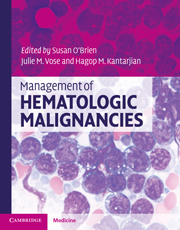Book contents
- Frontmatter
- Contents
- List of contributors
- 1 Molecular pathology of leukemia
- 2 Management of acute myeloid leukemia
- 3 Treatment of acute lymphoblastic leukemia (ALL) in adults
- 4 Chronic myeloid leukemia
- 5 Chronic lymphocytic leukemia/small lymphocytic lymphoma
- 6 Myelodysplastic syndromes (MDS)
- 7 Hairy cell leukemia
- 8 Acute promyelocytic leukemia: pathophysiology and clinical results update
- 9 Myeloproliferative neoplasms
- 10 Monoclonal gammopathy of undetermined significance, smoldering multiple myeloma, and multiple myeloma
- 11 Amyloidosis and other rare plasma cell dyscrasias
- 12 Waldenstrom's macroglobulinemia/lymphoplasmacytic lymphoma
- 13 WHO classification of lymphomas
- 14 Molecular pathology of lymphoma
- 15 International staging and response criteria for lymphomas
- 16 Treatment approach to diffuse large B-cell lymphomas
- 17 Mantle cell lymphoma
- 18 Follicular lymphomas
- 19 Hodgkin lymphoma: epidemiology, diagnosis, and treatment
- 20 Treatment approaches to MALT/marginal zone lymphoma
- 21 Peripheral T-cell lymphomas
- 22 Mycosis fungoides and Sézary syndrome
- 23 Central nervous system lymphoma
- 24 HIV-related lymphomas
- 25 Lymphoblastic lymphoma
- 26 Burkitt lymphoma
- Index
- References
17 - Mantle cell lymphoma
Published online by Cambridge University Press: 10 January 2011
- Frontmatter
- Contents
- List of contributors
- 1 Molecular pathology of leukemia
- 2 Management of acute myeloid leukemia
- 3 Treatment of acute lymphoblastic leukemia (ALL) in adults
- 4 Chronic myeloid leukemia
- 5 Chronic lymphocytic leukemia/small lymphocytic lymphoma
- 6 Myelodysplastic syndromes (MDS)
- 7 Hairy cell leukemia
- 8 Acute promyelocytic leukemia: pathophysiology and clinical results update
- 9 Myeloproliferative neoplasms
- 10 Monoclonal gammopathy of undetermined significance, smoldering multiple myeloma, and multiple myeloma
- 11 Amyloidosis and other rare plasma cell dyscrasias
- 12 Waldenstrom's macroglobulinemia/lymphoplasmacytic lymphoma
- 13 WHO classification of lymphomas
- 14 Molecular pathology of lymphoma
- 15 International staging and response criteria for lymphomas
- 16 Treatment approach to diffuse large B-cell lymphomas
- 17 Mantle cell lymphoma
- 18 Follicular lymphomas
- 19 Hodgkin lymphoma: epidemiology, diagnosis, and treatment
- 20 Treatment approaches to MALT/marginal zone lymphoma
- 21 Peripheral T-cell lymphomas
- 22 Mycosis fungoides and Sézary syndrome
- 23 Central nervous system lymphoma
- 24 HIV-related lymphomas
- 25 Lymphoblastic lymphoma
- 26 Burkitt lymphoma
- Index
- References
Summary
Introduction
Since its addition to the Revised European–American Lymphoma classification, in 1994, mantle cell lymphoma (MCL) has been recognized as carrying both features of indolent lymphoma (incurable) and a more aggressive course with short response to standard chemotherapy and common chemoresistance over time leading to very poor long-term prognosis. The disease presents typically in the elderly male population, with advanced-stage and constant extranodal involvement. There is still no consensus in the treatment of MCL; dose-intensification approaches with or without stem cell transplantation are commonly used in younger patients (< 65 years), though unfortunately patients still relapse over time. In the relapsed setting, the field is marked by the development of a large number of novel agents, especially biologicals or targeted therapies. The integration of these new agents to frontline conventional therapies will hopefully improve patients' outcome. On the other hand, evidence is mounting on the complexity and heterogeneity of MCL, which might be best described as a spectrum of diseases (based essentially on the degree of proliferation). The landmark t(11;14)(q13;q32) translocation, responsible for cyclin D1 overexpression, is in virtually all cases accompanied by additional secondary genomic alterations (genomic instability), which vary among patients and strongly impact clinical course and prognosis. Though the overall survival seems to have improved (doubled) in the last three decades, a better stratification of patients is needed as well as an effort for participation in clinical trials.
- Type
- Chapter
- Information
- Management of Hematologic Malignancies , pp. 308 - 337Publisher: Cambridge University PressPrint publication year: 2010



